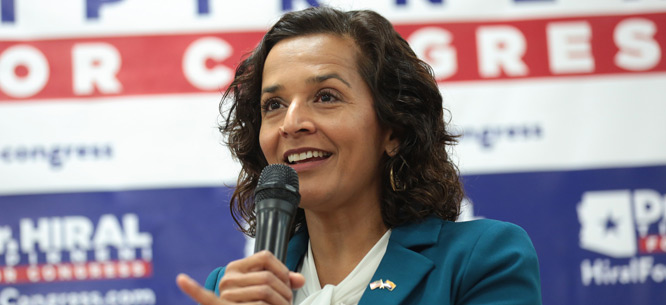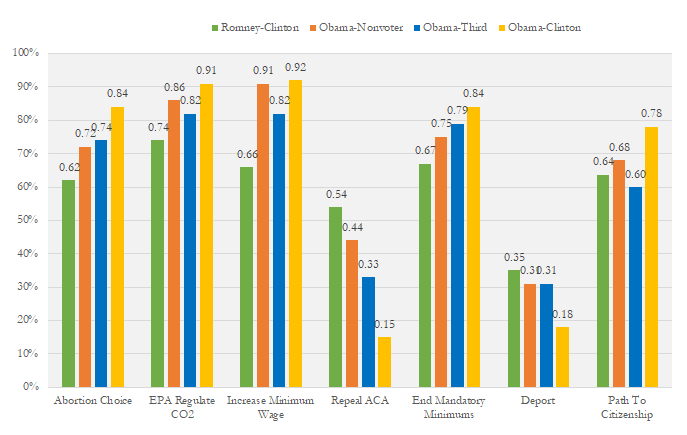Trust the Base
Trust the Base
Democratic Party leaders have slanted primaries toward bland centrists, in the hope of pleasing swing voters and big donors. This strategy gets just about everything wrong—and the data shows it.

As progressives have renewed an active engagement with the Democratic Party, few things have infuriated them more than the party hierarchy picking candidates. Recently, hundreds of audience members in a Democratic-leaning comedy podcast booed the Democratic Congressional Campaign Committee (DCCC), a sentence we couldn’t have imagined writing two years ago.
While there was ample criticism of the Democratic National Committee’s (DNC) performance in the 2016 presidential primary, far less attention has been paid to the role party leaders play in selecting down-ticket candidates. This process is a key mechanism by which the party fails—not only to uphold the values of its base and of the left, but at the ballot as well. If the Democratic Party doesn’t change the way it chooses candidates, we could be left with a reformed party with strong ideals—and no elected officials to advance them.
The role of the partyThere are a number of ways the national Democratic Party may influence which candidates run in primaries and which candidates win them. Sometimes, individual candidates get direct funding and endorsements from organs of the Democratic Party such as the DCCC or the Democratic Senatorial Campaign Committee (DSCC). This support may come with explicit or implicit fundraising support, access to email lists and voter files, and connections to local campaign staffers to help with phone banking and canvassing—critical needs for any nascent campaign. Unsurprisingly, such efforts can significantly tip the scales toward specific candidates at the expense of others who don’t receive such support.
One glaring example of the DCCC directly supporting a candidate took place in New York’s twenty-fourth district. In NY-24, after local parties and the local Indivisible groups had endorsed Dana Balter, the DCCC waded into the primary endorsing Juanita Perez Williams (who had previously run unsuccessfully for mayor of Syracuse) over the substantially more progressive frontrunner. It’s hard to make the case that this was a necessary intervention: Balter had strong fundraising and significant local support—and New York’s unique plural voting system means that the Working Families Party’s endorsement of Balter makes Williams substantially less likely to win in the general election.
Another intervention in an open primary occurred in the NJ-02 race this year. Although Tanzie Youngblood, a black former school teacher, had started receiving endorsements from local grassroots organizations, the DCCC instead chose to endorse Jeff Van Drew, a white state legislator with a 100 percent rating from the NRA and whose votes against same-sex marriage make him one of the most conservative Democrats in the state. Newsweek journalist Marie Solis described how local officials aligned themselves with the DCCC and have worked to undermine the Youngblood campaign.
Even without explicit endorsement, the Democratic Party often seeks to “clear the field”—explicitly or implicitly encouraging one or several candidates to drop out in order to consolidate support behind someone else. Since most congressional primaries are lightly polled (if at all), fundraising ability is often the only metric the party uses to guess at electability. Paul Perry, who briefly ran in PA-07, described in an article how his first contact with the DCCC outlined fundraising targets and how throughout his campaign he was asked how much time he was spending calling donors for money.
Clearing the field doesn’t even require official endorsements—instead, affiliated organizations (including Emily’s List, various PACs, and major unions, among others) help “pick a winner” and create an insurmountable early fundraising advantage. Even when there’s dissent, these groups often won’t go against the DCCC.
Such an early focus on fundraising creates significant biases toward candidates who can self-finance or who have access to a rolodex of donors. The party itself seems to show little concern for subtlety in these matters. Steny Hoyer, the second-highest ranking member of the Democratic House delegation, was recorded attempting to push a progressive challenger out of the CO-06 race in favor of a hand-picked centrist, Jason Crow. Crow is a wealthy corporate lawyer who has personally defended payday lenders and fracking firms, and who works for a firm that lobbies against gun control. These are not the values of an engaged base in a district that voted 50-41 for Clinton in 2016.
Hoyer is remarkably frank, admitting that “Staying out of primaries sounds small-D democratic, very intellectual, and very interesting,” but that he fears the primary winner may not be as competitive in the general as the hand-picked winner. Yet there’s no evidence that the centrist in this race was more popular with a general electorate—nor was there any attempt to establish who was most likely to win. Crow was able to fundraise thanks to his own wealth and his contacts as a corporate lawyer—any impact that had on “small-D” democracy wasn’t a concern.
Another example of myopia comes from the third district of Iowa, which Trump narrowly won 49-45 and Obama took by 4 percentage points. One candidate, Austin Frerick, started attracting national attention for compelling messaging around monopolies—specifically focusing on the proposed Bayer-Monsanto merger. Frerick was able to connect corporate consolidation with bread-and-butter issues affecting the people of his district by talking about how corporate power affected the price of corn seed. While thinktanks like the Open Markets Institute and the Roosevelt Institute have been trying to revive antritrust laws as a major organizing platform, Frerick was in the field doing the work, talking to Iowans about how agribusiness mergers negatively impacted farmers’ bottom lines.
Yet Frerick found himself in a fundraising bind—lacking deep pockets himself or having ties to large donors, he failed to raise $100,000 in his first quarter. This convinced the party that he was unable to win—leading them to remain on the sidelines, which in turn prevented him from raising his profile further. Local officials followed along with the party—this is the playbook that the Democrats have run for over a decade. Frerick dropped out once it became clear that his inability to raise money meant his opponents would receive more party support.
Balter, Youngblood, and Frerick are exactly the kinds of candidates the Democrats need to be recruiting and training in order to win competitive races—yet explicit and implicit party forces sideline them and keep their voices out of debates. In their place are more moderate and less compelling candidates who fail to engage the base. While the party leadership may be enamored by well-funded moderates, voters aren’t. These candidates consistently underperform in general elections, often losing races that more progressive Democrats would have won.
Even in favorable electoral cycles, like the 2018 midterms where Democratic candidates are significantly surpassing recent results, moderates still struggle. While the media focused heavily on Connor Lamb and Doug Jones, both won with unique advantages: Lamb was seeking to replace a retiring incumbent who had resigned in disgrace after encouraging his mistress to get an abortion. Jones beat Roy Moore, a uniquely vile individual who was credibly accused of being a pedophile during the course of the election. Neither Jones nor Lamb broke 50 percent of the vote—and neither is actually as moderate as the party liked to portray. Jones ran on an unapologetically pro-choice platform in Alabama and won.
Jon Ossoff, another moderate with significant party support and little actual vision lost a winnable race in the 6th district of Georgia. Ossoff also faced a particularly compromised opponent in Karen Handel and raised the most money ever spent on a congressional race—yet he lost by a larger margin than Hillary Clinton despite the favorable national environment.
There is recent evidence that shows moderates perform worse than progressives in general elections. Hiral Tipirneni performed better than Clinton by 20 points in Arizona, running on universal healthcare and opposition to Trump’s tax cuts. A woman of color running on an unabashedly progressive platform ran ahead of Lamb, Jones, and Ossoff, yet the Beltway wisdom remains that it’s time to invest in centrist white men. And, disturbingly, despite women leading the resistance, the DCCC interventions this cycle have overwhelmingly favored men over women.
Results like these lead Democratic leaders to the wrong conclusions. When moderates win, it’s proof that the party should move to the center. When moderates lose, it’s proof that the districts themselves are challenging for Democrats to win—and the answer is to find even more moderate candidates. The cycle continues anew.
A leadership out of touchDemocratic office-holders tend to believe—mistakenly—that the population they represent is more conservative than it really is. Political scientists David Broockman and Christopher Skovron surveyed 3,765 politicians and compared their perceptions of voter opinion to modelled support for policies in their districts. Broockman and Skovron found that politicians from both parties dramatically overestimated the conservatism of their constituents. Another study by Skovron and Broockman with Nicholas Carnes and Melody Crowder-Meyer examined party leaders. Here, they not only found that Democratic leaders perceive voters to be more conservative than they really are, but also that these leaders prefer centrists to progressives.
Democratic Party leaders also perceived a trade-off between moderation and electoral success, which is tied to an out-moded theory of politics in which persuading swing voters is more important than mobilizing the base. The data actually points in the other direction—moderate candidates consistently fail to engage voters and the loss of the base is not made up for by an increase in swing voters.
In this worldview, when Democrats lose, it’s because they failed to convince enough swing voters, the solution to which is supporting even more conservative candidates in the next cycle. Indeed the DCCC seems to explicitly prefer candidates who do not support the bold ideas of this cycle: Medicare for All, a $15 minimum wage, abolishing ICE, or ending cash bail.
And when these more moderate candidates do win, they find themselves out of touch with their electorate from the beginning. This creates unpopular incumbents who stand for nothing and whose failure to pass popular legislation will undermine any successes we have in reforming the party. Without a local base of engaged voters, these candidates are permanently dependent on the national party for their re-election campaign. This makes them extremely vulnerable to strong challenges from the right. Indeed, Rahm Emanuel’s famed class of moderates from 2006 found themselves without significant local support in 2010. While strong progressive candidates from 2006 like Keith Ellison and Chris Murphy remain popular, candidates Emanuel recruited like Heath Shuler and Brad Ellsworth (both of whom are anti-choice) are no longer in office and their seats are now held by Republicans.
A progressive party is a winning partyProgressive think tank Data for Progress researched the political geography of policies like Medicare for All, a job guarantee, ending mandatory minimums, regulating carbon emissions, and repealing the Second Amendment, and found that these issues are quite popular across the country. In other words, there is little evidence that Democrats would face a backlash for endorsing them.
The marginal voters (individuals who drift in and out of the electorate) certainly don’t oppose them. Using the Cooperative Congressional Election Studies (CCES) 2016 survey, we found that voters who went for Obama in 2012 and then did not vote in 2016 are overwhelmingly supportive of the progressive option on these issues. The same is true of Obama voters in 2012 who then chose a third party in 2016. These are potential Clinton voters whose votes could have made a significant difference in the 2016 election.

Policy views of different voter groups. Source: CCES 2016
And moving to the right failed to get enough votes to counteract the losses. Compared to the voting bloc above, there were fewer voters who went for Romney in 2012 and then Clinton in 2016 than who voted for Obama and stayed home in 2016. And these voters who switched to Clinton are far away from the Democratic base on most policy issues. This means that the marginal gain of moving to the center to pick up more moderates will be offset by losing even more of the core Democratic base.
Growing frustrationLocal activists are increasingly unhappy with interventions from the Democratic Party leadership. They believe that national leaders are out of touch with local conditions and are interfering to privilege candidates who are themselves out-of-step with the base. In NY-24, four Democratic county chairs published an open letter criticizing the DCCC not just for interfering in their race but in races all over the country. They did not mince words: “From people engaged for the very first time this year, to party and elected officials we stand united behind our designated nominee Dana Balter and against the DC meddling that has hampered far too many races thus far.”
Activists across the country are united in this criticism. And they’re right. Democratic voters are moving to the left on a number of key issues, from healthcare to racial justice. There’s almost no possible coalition to win without capturing these voters—yet party leaders seem to fear the ghost of George McGovern lurks around every corner. For some reason, Democratic leaders believe that progressive ideas are only popular in deep blue districts—but the data says otherwise.
Despite this growing anger against the party’s leadership, millions of people have turned out the vote for Democratic candidates in special elections since Trump’s victory. What drives their anger with the DCCC is also what gets them to the polls—their commitment to progressive values. And the big victories in Alabama and Pennsylvania also came without any party interference in a competitive primary.
Fixing candidate selectionThe goal of the DSCC and DCCC should be to ensure Democratic majorities in both chambers. Right now the best path to a majority is to support candidates with strong progressive visions. We recognize that candidates can have many non-ideological strengths: they may be better on the campaign trail, they may have stronger ties to the community, or they may have a more compelling narrative. But even in such cases, DCCC interference can be a mistake. After years of supporting moderates at the cost of progressives, national support of a leading moderate will often cause resentment from supporters of a losing but more progressive candidate, and can cause rifts in the coalition going into a general election.
We saw this in TX-07, where the DCCC took the unprecedented move of dropping opposition research against a member of its own party, catapulting the candidate they intended to destroy into the run-off. While ultimately this candidate lost the primary, it caused significant backlash and may have hampered the attempt to defeat the Republican incumbent—which should have been a straightforward task given that Hillary Clinton won the district in 2016,
Instead of interfering directly or indirectly in primaries, the Democratic Party should decide not to provide unique resources to any one candidate until after the primary. This is a start, though not enough.
Well-funded moderates will continue to have advantages over newcomers like Austin Frerick and Tanzie Youngblood—even though the moderate position often resonates less with general election voters. Putting up uninspiring moderates not only keeps many voters home—it fails to draw new voters to the Democratic Party or show how progressive policies can improve people’s lives.
If the Democratic Party is serious about winning competitive elections in swing districts, it needs to go further and help level the playing field so that the independently wealthy don’t consistently beat out more progressive but less wealthy candidates. The DSCC and DCCC could prohibit candidates from self-financing or put limits on the percentage of donations above a certain amount. One idea may be to adopt a luxury tax similar to that of Major League baseball, where candidates who raise significant sums are forced to cross-subsidize those without deep pockets. Maximum caps on individual donations can also help put candidates on equal footing. There may be some concern that this will inhibit the development of a professional campaign prior to the general election—but in the long-term, this will be dwarfed by the impact of creating an engaged voting public that knows the Democratic party is not for sale.
In the end, the rich may continue to win out more often than not—that’s how the balance of power works in our society. Any limitations on fundraising will force vested interests to look elsewhere—from PAC money to various forms of chicanery designed to limit the ability of progressives to tap into their own voting power. Yet Democrats ought to put a thumb on the other side of the scale for a change, if only for their own self-interest.
The donor class dodgeWhat’s missing from this narrative is any discussion of the impact of big donors on the party. As the story goes, these donors are generally receptive to socially liberal causes but prefer low-tax and low-regulation regimes that personally benefit them—thus moving the party away from the working class and aligning it with the toothless politics of a coastal urban elite. While the narrative has explanatory power, data shows it’s just not accurate. Not only are major donors to the left of small donors, they’re genuinely to the left of where they perceive the Democratic Party as a whole and individual candidates.
We used the Cooperative Congressional Election Studies 2016 survey to analyze all Democrats, all Clinton voters, primary voters, meeting attendees, volunteers, individuals who put up a campaign sign, small donors (who gave under $200), and large donors. Perhaps surprisingly, large donors’ views are more likely to place them further to the left of the Democratic Party than all these other groups.
One could imagine that donors might perceive themselves as broadly liberal, but see this mostly as a cultural affinity. In a separate analysis, we examined the American National Election Studies 2016 survey and found the same result: large Democratic donors placed themselves to the left of Democratic voters on issues of social services and increased government spending.
To be clear, the power of monied interests hurts the left for a wide variety of reasons. Further, we don’t doubt that there is a point at which, say, a George Soros would be to the right of the center of the Democratic Party. For now though, the main threat money poses to the left is largely through the Kochs and corporate PACs, rather than the insufficient liberalism of major donors.
A Tea Party for the left?While activists and local officials have started to express anger with the DCCC, large donors should be equally angry. Why would anyone bother giving millions to a party that simultaneously scorns their views and loses winnable elections? It’s hard to listen to Steny Hoyer cavalierly acknowledge the DCCC’s undemocratic role and not think that donors are giving their savings to a gambler who keeps betting on the same losing horse while insisting that nobody understands his process.
If this sounds familiar, it’s the exact situation the Koch brothers and other major conservative donors found themselves in after the 2008 election. After losing control of the White House and both branches of Congress, the Koch brothers realized that it was a waste of money to support milquetoast moderate candidates like Norm Coleman, Elizabeth Dole, Gordon Smith, Bob Schaffer, and others. They worked with an energized base to create a new power structure that empowered outsider candidates with views that better reflected that of the base—and not only did these candidates win primaries, they often won general elections too.
The party’s ability to influence candidate selection depends heavily on the dollars it can spend, powered in part by large donors. If the Democrats fail to reform how they handle competitive primaries, it’s only a matter of time before the base and the mega-donors figure out how to bypass the party. A left Tea Party will start putting forward populist candidates in primaries that don’t just beat the party’s moderate favorites, but perhaps even beat sitting elected officials who are out of touch with their voters.
Progressives also shouldn’t despair: in a recent race, progressive candidate Kara Eastman was able to overcome a fundraising deficit and a DCCC endorsement by mobilizing grassroots support. If she wins in November, it should leave a question mark next to the idea that the DCCC has a good enough track record picking candidates to justify sidelining qualified progressives.
The Democratic Party is currently benefiting from the power of the activist base. However, they should worry that aggressively pushing their base toward bland, centrist candidates will backfire. Intervening against the base will only weaken the party, and so far, voters have proven perfectly capable of choosing the best candidates. Let them.
Mark Egerman is a longtime activist and donor to progressive candidates and organizations.
Sean McElwee is a co-founder of Data for Progress. He tweets at @SeanMcElwee.







